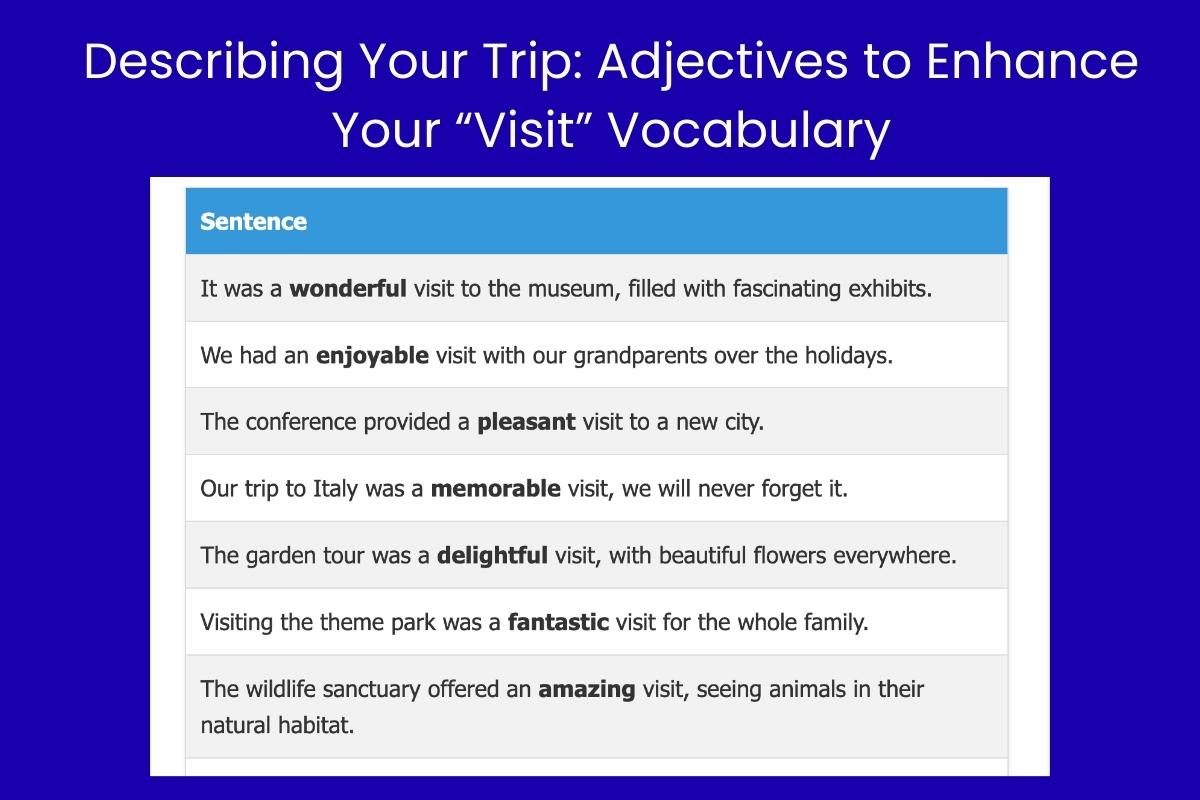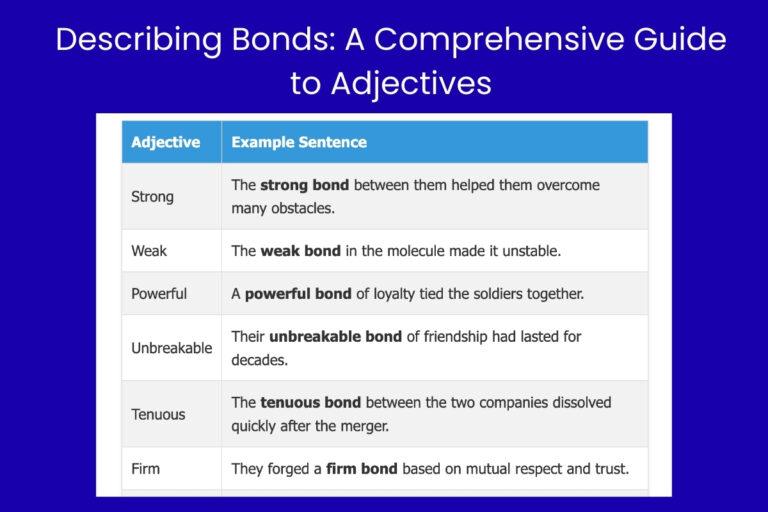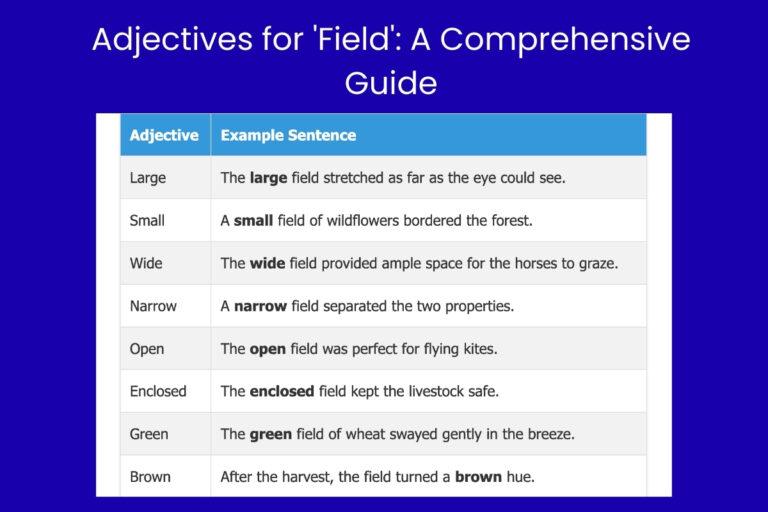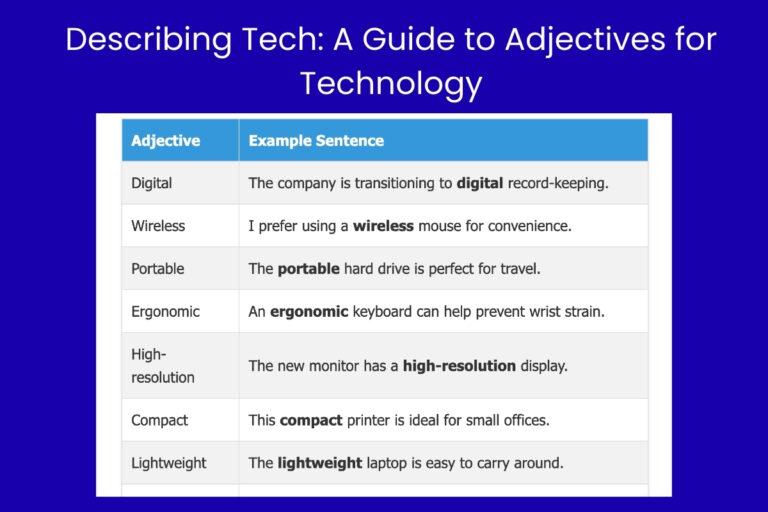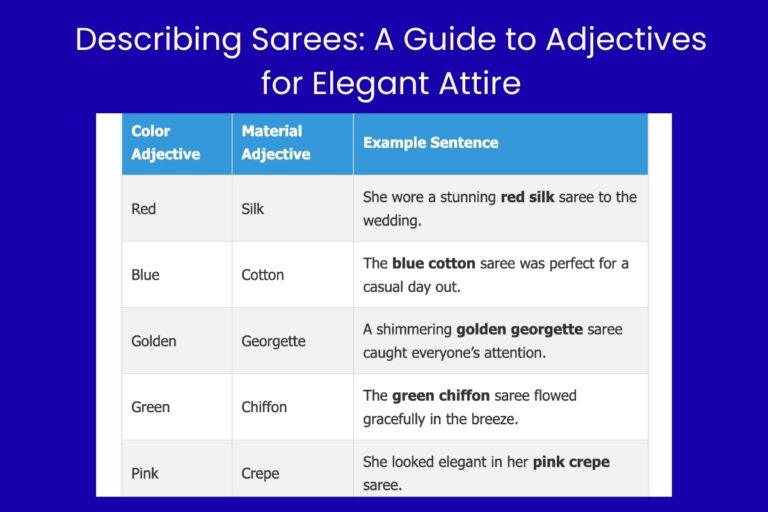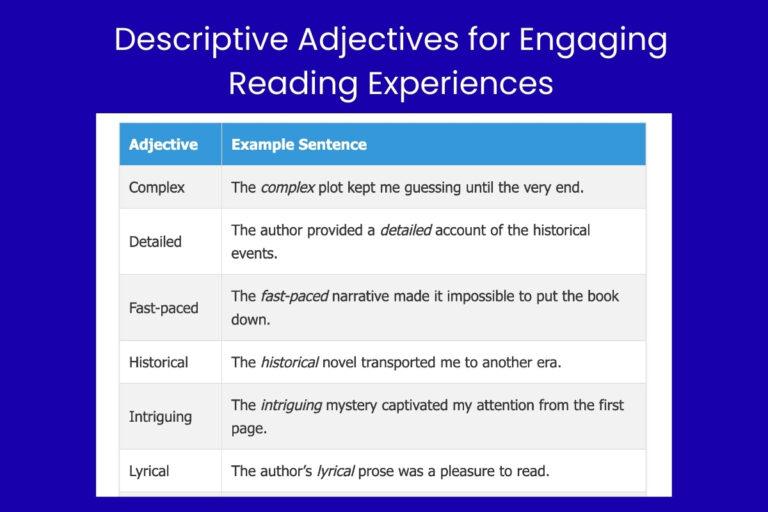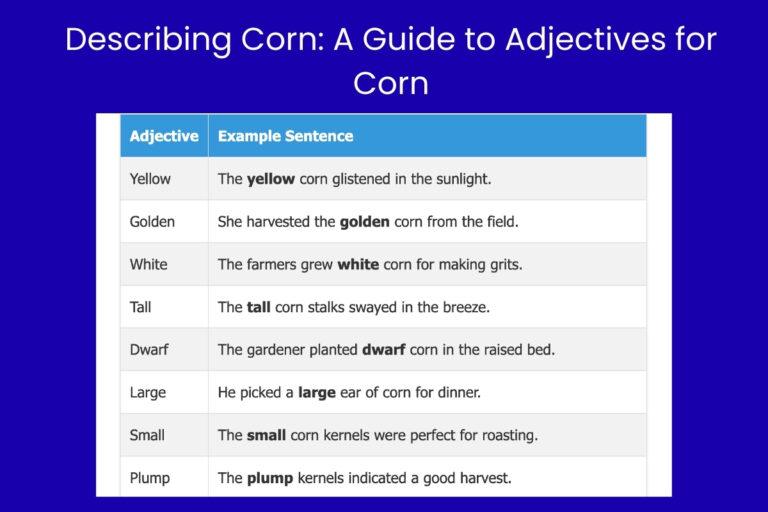Describing Your Trip: Adjectives to Enhance Your “Visit” Vocabulary
Choosing the right adjectives can transform a simple description into a vivid and engaging narrative. When it comes to describing a “visit,” the adjectives you select can significantly impact how your audience perceives the experience. Whether it’s a short trip to a nearby town or an extended vacation abroad, using descriptive adjectives helps convey the atmosphere, emotional impact, and overall quality of the visit. This article will explore a wide range of adjectives perfect for describing visits, providing examples, usage rules, and practice exercises to enhance your vocabulary and descriptive writing skills. This guide is ideal for students, travelers, writers, and anyone looking to improve their ability to articulate their experiences effectively.
By mastering these adjectives, you’ll be able to paint a more detailed and compelling picture of your visits, making your stories more captivating and your communication more effective. Let’s dive in and explore the world of adjectives for visits!
Table of Contents
- Introduction
- Definition of Adjectives for “Visit”
- Structural Breakdown
- Types of Adjectives for Describing Visits
- Examples of Adjectives in Sentences
- Usage Rules for Adjectives
- Common Mistakes
- Practice Exercises
- Advanced Topics
- FAQ
- Conclusion
Definition of Adjectives for “Visit”
Adjectives are words that describe or modify nouns. When used to describe a “visit,” adjectives provide detailed information about the nature, quality, duration, purpose, or impact of the visit. They help to create a more vivid and comprehensive understanding of the experience. These adjectives can highlight specific aspects of the visit, such as its excitement, relaxation, or educational value.
These adjectives add depth and nuance to descriptions, allowing the speaker or writer to convey their personal impression of the visit. The correct use of these adjectives can significantly enhance communication, making it more engaging and informative.
Structural Breakdown
The structure of using adjectives to describe a visit typically involves placing the adjective before the noun “visit.” This is the most common and straightforward structure in English. However, adjectives can also be used after linking verbs (such as “was,” “seemed,” or “appeared”) to describe the visit.
Basic Structure: Adjective + Visit (e.g., memorable visit, brief visit)
Alternative Structure: The visit + Linking Verb + Adjective (e.g., The visit was memorable, The visit seemed brief)
It’s also possible to use multiple adjectives to provide a more detailed description. In such cases, the order of adjectives often follows certain conventions, such as placing opinion adjectives before fact-based adjectives. For example: “It was a wonderful, educational visit.”
Types of Adjectives for Describing Visits
Adjectives for describing visits can be categorized based on the type of quality they describe. Here are some common categories:
Positive Adjectives
These adjectives convey a favorable impression of the visit. They highlight enjoyable or beneficial aspects of the experience.
- Wonderful
- Enjoyable
- Pleasant
- Memorable
- Delightful
- Fantastic
- Amazing
- Lovely
- Excellent
- Superb
Negative Adjectives
These adjectives convey an unfavorable impression of the visit. They highlight unpleasant or problematic aspects of the experience.
- Terrible
- Awful
- Dreadful
- Unpleasant
- Disappointing
- Frustrating
- Stressful
- Tiring
- Boring
- Horrible
Neutral Adjectives
These adjectives provide descriptive information without conveying a strong positive or negative impression. They focus on factual aspects of the visit.
- Brief
- Short
- Long
- First
- Second
- Annual
- Regular
- Official
- Business
- Casual
Adjectives Describing Duration
These adjectives specify the length or timing of the visit.
- Prolonged
- Extended
- Brief
- Short
- Quick
- Lengthy
- Fleeting
- Momentary
- Overnight
- Day-long
Adjectives Describing Purpose
These adjectives describe the reason or intention behind the visit.
- Business
- Social
- Official
- Educational
- Medical
- Personal
- Professional
- Research
- Inspection
- Recreational
Adjectives Describing Impact
These adjectives describe the effect or influence the visit had.
- Impactful
- Meaningful
- Transformative
- Insightful
- Enlightening
- Inspiring
- Productive
- Successful
- Unsuccessful
- Beneficial
Examples of Adjectives in Sentences
The following tables provide examples of how to use different types of adjectives to describe a “visit” in various contexts. Each table focuses on a specific category of adjectives, illustrating their usage in sentences.
Table 1: Positive Adjectives
This table presents examples of sentences using positive adjectives to describe a visit, showcasing how these words can convey a favorable impression.
| Sentence |
|---|
| It was a wonderful visit to the museum, filled with fascinating exhibits. |
| We had an enjoyable visit with our grandparents over the holidays. |
| The conference provided a pleasant visit to a new city. |
| Our trip to Italy was a memorable visit, we will never forget it. |
| The garden tour was a delightful visit, with beautiful flowers everywhere. |
| Visiting the theme park was a fantastic visit for the whole family. |
| The wildlife sanctuary offered an amazing visit, seeing animals in their natural habitat. |
| Our stay at the beach house was a lovely visit, so relaxing and peaceful. |
| The guided tour of the historical site was an excellent visit, very informative. |
| The concert was followed by a superb visit backstage to meet the musicians. |
| The beautiful visit to the botanical garden was a treat for the senses. |
| We had a splendid visit to the art gallery, admiring the masterpieces. |
| The charming visit to the countryside was a welcome escape from the city. |
| Our fulfilling visit to the orphanage left us feeling grateful and inspired. |
| The gratifying visit to the animal shelter made us want to adopt a pet. |
| It was a remarkable visit, uncovering hidden gems in the old town. |
| The satisfying visit to the local market allowed us to taste authentic cuisine. |
| We had a thrilling visit to the amusement park, riding all the roller coasters. |
| Our unforgettable visit to the national park created memories that will last a lifetime. |
| The vibrant visit to the street fair was filled with music, food, and art. |
| The peaceful visit to the monastery was a time for reflection and contemplation. |
| Our refreshing visit to the spa left us feeling rejuvenated and relaxed. |
| It was a rewarding visit to the community center, volunteering our time and skills. |
| The serene visit to the lake was a perfect escape from the hustle and bustle of city life. |
| Our uplifting visit to the hospital brought smiles to the faces of the patients. |
Table 2: Negative Adjectives
This table provides examples of sentences using negative adjectives, illustrating how these words can convey an unfavorable or disappointing experience.
| Sentence |
|---|
| It was a terrible visit to the dentist, filled with pain and discomfort. |
| We had an awful visit to the amusement park, due to the long lines and bad weather. |
| The meeting turned out to be a dreadful visit, with nothing accomplished. |
| Our trip to the crowded city was an unpleasant visit, filled with stress and noise. |
| The museum tour was a disappointing visit, as many exhibits were closed for renovation. |
| The airport security check was a frustrating visit, with endless delays. |
| Visiting the hospital was a stressful visit, worrying about our loved one’s health. |
| The construction site was a tiring visit, walking through the rubble and dust. |
| The lecture turned out to be a boring visit, with a monotone speaker and dull content. |
| The haunted house was a horrible visit, filled with jump scares and fake blood. |
| The aggravating visit to the DMV was a waste of time and energy. |
| We had a distressing visit to the emergency room, witnessing the suffering of others. |
| The exasperating visit to the repair shop resulted in more problems than solutions. |
| Our gruesome visit to the abandoned building left us feeling disturbed and uneasy. |
| The harrowing visit to the war memorial brought tears to our eyes. |
| It was an infuriating visit, dealing with incompetent customer service. |
| The jarring visit to the factory was filled with loud noises and unpleasant smells. |
| Our lousy visit to the restaurant resulted in terrible food and poor service. |
| The miserable visit to the beach was ruined by rain and cold weather. |
| It was a nasty visit, encountering rude and disrespectful people. |
| The offensive visit to the comedy club was filled with inappropriate jokes. |
| Our painful visit to the doctor’s office was unavoidable, but still unpleasant. |
| The questionable visit to the shady neighborhood made us feel unsafe. |
| It was a regrettable visit, making decisions we later wished we could undo. |
| The sickening visit to the slaughterhouse was a disturbing and unforgettable experience. |
Table 3: Neutral Adjectives
This table presents examples of sentences using neutral adjectives to describe a visit, focusing on factual aspects without conveying strong positive or negative impressions.
| Sentence |
|---|
| It was a brief visit to the neighboring town, just a quick stopover. |
| We had a short visit with our cousins, as they were very busy. |
| The doctor’s appointment was a quick visit, lasting only fifteen minutes. |
| Our trip to the capital city was a long visit, spanning several days. |
| It was my first visit to the country, and I was excited to explore. |
| This is our second visit to the theme park this year. |
| We make an annual visit to the family cabin in the mountains. |
| It’s a regular visit to the library for us, every Saturday morning. |
| The delegation made an official visit to the embassy. |
| It was a business visit to discuss potential partnerships. |
| We had a casual visit with friends, just catching up over coffee. |
| It was a formal visit, requiring us to dress in our best attire. |
| The prearranged visit ensured we had access to all the facilities. |
| It was a scheduled visit, planned well in advance to avoid conflicts. |
| The impromptu visit caught us by surprise, but it was a pleasant one. |
| Our guided visit provided us with valuable insights into the history of the place. |
| It was an independent visit, allowing us to explore at our own pace. |
| The supervised visit ensured the safety and well-being of everyone involved. |
| Our return visit was just as enjoyable as the first one. |
| It was a routine visit to the doctor for a check-up. |
| The subsequent visit confirmed our initial findings. |
| Our previous visit had prepared us for what to expect this time. |
| It was a trial visit to see if we liked the accommodation. |
| The usual visit to the coffee shop was a comforting start to the day. |
| Our weekly visit to the farmer’s market is a tradition we cherish. |
Table 4: Adjectives Describing Duration
This table showcases sentences using adjectives to describe the duration of a visit, highlighting how these words can specify the length or timing of the experience.
| Sentence |
|---|
| The prolonged visit to the hospital was necessary for extensive treatment. |
| We had an extended visit with family over the summer, lasting several weeks. |
| It was a brief visit to the museum, as we only had an hour to spare. |
| Our short visit to the city allowed us to see only a few of the main attractions. |
| It was a quick visit to the grocery store to pick up a few items. |
| The lengthy visit to the historical site required comfortable shoes and plenty of water. |
| It was a fleeting visit, barely enough time to say hello before we had to leave. |
| The momentary visit was just a brief stop to drop off a package. |
| We had an overnight visit with friends who lived in a neighboring town. |
| It was a day-long visit to the amusement park, filled with rides and entertainment. |
| The week-long visit gave us ample time to explore the region. |
| It was a month-long visit, immersing ourselves in the local culture. |
| The year-long visit allowed us to learn the language fluently. |
| It was a continuous visit, with no breaks or interruptions. |
| The intermittent visit was interrupted by unforeseen circumstances. |
| It was a temporary visit, as we were only passing through. |
| The permanent visit marked our relocation to a new city. |
| It was a one-time visit, with no plans for a return trip. |
| The repeat visit was just as enjoyable as the first. |
| It was a scheduled visit, planned well in advance. |
| The unscheduled visit caught us by surprise. |
| It was a prolonged visit due to unexpected delays. |
| The rushed visit didn’t allow us to fully appreciate the experience. |
| It was a leisurely visit, with plenty of time to relax and unwind. |
| The extended visit strengthened our bond with family. |
Table 5: Adjectives Describing Purpose
This table provides examples of sentences using adjectives to describe the purpose of a visit, highlighting how these words can specify the reason or intention behind the experience.
| Sentence |
|---|
| It was a business visit to negotiate a new contract with the supplier. |
| We had a social visit with friends to celebrate their anniversary. |
| The ambassador made an official visit to the neighboring country. |
| It was an educational visit to the science museum for the students. |
| We had a medical visit to the specialist for a check-up. |
| It was a personal visit to see my grandmother in the nursing home. |
| The consultant made a professional visit to assess the company’s performance. |
| It was a research visit to the library to gather information for my thesis. |
| The health inspector made an inspection visit to the restaurant. |
| We had a recreational visit to the park for a picnic and games. |
| It was a court-ordered visit for the child to see their parent. |
| The fact-finding visit aimed to gather information about the incident. |
| It was a goodwill visit to promote peace and understanding. |
| We had a learning visit to the workshop to acquire new skills. |
| It was a networking visit to connect with industry professionals. |
| The observation visit allowed us to see the process in action. |
| It was a planning visit to discuss the details of the event. |
| We had a rescue visit to save the stranded animals. |
| It was a scouting visit to find the perfect location for the film. |
| The training visit equipped us with the necessary skills. |
| It was a validation visit to confirm the accuracy of the data. |
| We had a welfare visit to check on the well-being of the family. |
| It was an exploratory visit to discover new opportunities. |
| The fundraising visit aimed to gather donations for the charity. |
| We had a healing visit to the retreat to recover from stress. |
Usage Rules for Adjectives
When using adjectives to describe a visit, several rules should be followed to ensure clarity and grammatical correctness:
- Placement: Adjectives usually come before the noun they modify. For example: “memorable visit,” not “visit memorable.”
- Multiple Adjectives: When using multiple adjectives, follow the order of adjectives (opinion, size, age, shape, color, origin, material, purpose). For example: “a lovely, short visit.”
- Linking Verbs: After linking verbs (is, are, was, were, seems, appears), adjectives follow the verb. For example: “The visit was enjoyable.”
- Articles: Use articles (a, an, the) appropriately based on whether the noun is specific or non-specific, and whether the adjective begins with a vowel sound. For example: “a pleasant visit,” “an amazing visit,” “the official visit.”
- Hyphenation: Compound adjectives (two or more words acting as a single adjective) should be hyphenated when they come before the noun. For example: “a well-planned visit.”
Common Mistakes
Learners often make mistakes when using adjectives. Here are some common errors and how to correct them:
Incorrect: “Visit memorable.”
Correct: “Memorable visit.”
Incorrect: “The visit was enjoy.”
Correct: “The visit was enjoyable.”
Incorrect: “A amazing visit.”
Correct: “An amazing visit.”
Incorrect: “Well planned visit.”
Correct: “Well-planned visit.”
Incorrect: “He had a visit good.”
Correct: “He had a good visit.”
Practice Exercises
Test your understanding of adjectives for describing visits with the following exercises.
Exercise 1: Fill in the Blanks
Complete the following sentences with appropriate adjectives.
| Question | Answer |
|---|---|
| 1. We had a ________ visit to the art gallery. | 1. We had a fascinating visit to the art gallery. |
| 2. The meeting was a ________ visit, with no progress made. | 2. The meeting was a frustrating visit, with no progress made. |
| 3. It was a ________ visit to the doctor for a routine check-up. | 3. It was a regular visit to the doctor for a routine check-up. |
| 4. The ________ visit to the historical site took us back in time. | 4. The guided visit to the historical site took us back in time. |
| 5. Our ________ visit with family lasted for several weeks. | 5. Our extended visit with family lasted for several weeks. |
| 6. It was a ________ visit to discuss the project details. | 6. It was a planning visit to discuss the project details. |
| 7. The concert was followed by a ________ visit backstage. | 7. The concert was followed by a delightful visit backstage. |
| 8. The ________ visit to the abandoned house gave us chills. | 8. The eerie visit to the abandoned house gave us chills. |
| 9. It was a ________ visit, quickly dropping off the package. | 9. It was a brief visit, quickly dropping off the package. |
| 10. We had a ________ visit to volunteer at the local shelter. | 10. We had a fulfilling visit to volunteer at the local shelter. |
Exercise 2: Choose the Correct Adjective
Select the most appropriate adjective from the options provided.
| Question | Answer |
|---|---|
| 1. It was a (terrible / wonderful) visit to the beach, soaking up the sun. | 1. It was a wonderful visit to the beach, soaking up the sun. |
| 2. The (short / lengthy) visit to the museum allowed us to see every exhibit. | 2. The lengthy visit to the museum allowed us to see every exhibit. |
| 3. We had a (social / business) visit to discuss the new marketing strategy. | 3. We had a business visit to discuss the new marketing strategy. |
| 4. The (amazing / awful) visit to the zoo left us feeling sad for the animals. | 4. The awful visit to the zoo left us feeling sad for the animals. |
| 5. It was a (quick / prolonged) visit to the doctor for a follow-up appointment. | 5. It was a quick visit to the doctor for a follow-up appointment. |
| 6. Our (educational / boring) visit to the planetarium sparked our interest in astronomy. | 6. Our educational visit to the planetarium sparked our interest in astronomy. |
| 7. The (official / casual) visit required us to wear formal attire. | 7. The official visit required us to wear formal attire. |
| 8. We had a (pleasant / stressful) visit to the airport, dealing with flight delays. | 8. We had a stressful visit to the airport, dealing with flight delays. |
| 9. It was a (memorable / forgettable) visit, creating memories that will last a lifetime. | 9. It was a memorable visit, creating memories that will last a lifetime. |
| 10. The (inspiring / tiring) visit to the mountain peak left us breathless. | 10. The tiring visit to the mountain peak left us breathless. |
Exercise 3: Rewrite the Sentences
Rewrite the following sentences using more descriptive adjectives.
| Original Sentence | Rewritten Sentence |
|---|---|
| 1. It was a good visit. | 1. It was a splendid visit, filled with joy and laughter. |
| 2. The visit was long. | 2. The visit was surprisingly lengthy, stretching over several delightful days. |
| 3. We had a visit. | 3. We had a meaningful visit, reconnecting with old friends. |
| 4. The visit was bad. | 4. The visit was an utterly dreadful experience, plagued by constant setbacks. |
| 5. It was a visit to the museum. | 5. It was an engrossing visit to the museum, where we discovered fascinating artifacts. |
| 6. The visit was for business. | 6. The visit was a crucial business trip, aimed at securing a lucrative deal. |
| 7. We had a short visit. | 7. We had a brief visit, just enough time for a quick hello. |
| 8. The visit was educational. | 8. The visit was an incredibly educational experience, expanding our understanding of the world. |
| 9. It was a visit to the park. | 9. It was a relaxing visit to the park, enjoying the serene surroundings. |
| 10. The visit was official. | 10. The visit was a formal official event, requiring strict adherence to protocol. |
Advanced Topics
For advanced learners, consider these more complex aspects of using adjectives for visits:
- Figurative Language: Using metaphors and similes to describe the visit (e.g., “The visit was a breath of fresh air”).
- Subjunctive Mood: Expressing wishes or hypothetical situations related to the visit (e.g., “I wish the visit were longer”).
- Complex Sentence Structures: Combining multiple clauses to provide detailed descriptions (e.g., “Although the visit was brief, it was incredibly impactful, leaving a lasting impression on everyone”).
FAQ
Here are some frequently asked questions about using adjectives to describe visits:
- Q: Can I use more than three adjectives to describe a visit?
A: Yes, you can use more than three adjectives, but be mindful of clarity. Too many adjectives can make the sentence cumbersome. Prioritize the most relevant and impactful adjectives. - Q: What is the correct order of adjectives when using multiple adjectives?
A: The general order is: opinion, size, age, shape, color, origin, material, and purpose. For example: “a lovely, small, old, round, blue, Italian, wooden table.” - Q: How do I choose the best adjective to describe a visit?
A: Consider the specific aspects of the visit you want to highlight. Think about the emotions, experiences, and overall impression you want to convey. Use a thesaurus to explore different options and choose the most fitting adjective. - Q: Can I use adverbs to modify adjectives describing a visit?
A: Yes, adverbs can be used to intensify or qualify adjectives. For example: “incredibly memorable visit,” “somewhat disappointing visit.” - Q: Are there any adjectives that should be avoided when describing a visit?
A: Avoid using overly vague or generic adjectives like “good” or “bad.” Instead, opt for more specific and descriptive adjectives that provide more detail and nuance. - Q: How can I improve my vocabulary of adjectives for describing visits?
A: Read widely, pay attention to how authors use adjectives, and make a conscious effort to learn new words. Use flashcards, vocabulary apps, and practice writing descriptions to reinforce your learning. - Q: Is it okay to use subjective adjectives when describing a visit?
A: Yes, subjective adjectives (those based on personal opinions or feelings) are perfectly acceptable, especially when you are sharing your own experiences. Just be clear that you are expressing your personal perspective. - Q: How can I make my descriptions of visits more engaging?
A: Use vivid and descriptive adjectives, incorporate sensory details (sights, sounds, smells, tastes, textures), and share personal anecdotes to bring your descriptions to life.
Conclusion
Mastering the use of adjectives to describe a “visit” can significantly enhance your communication skills, allowing you to articulate your experiences more effectively and engage your audience more deeply. By understanding the different types of adjectives, following usage rules, and practicing regularly, you can expand your vocabulary and improve your descriptive writing. Remember to choose adjectives that accurately reflect the nature, quality, and impact of the visit you are describing.
